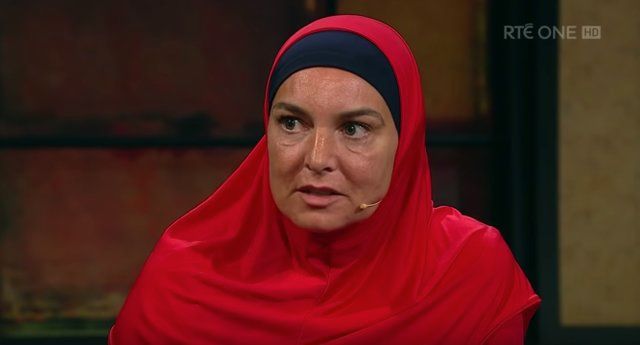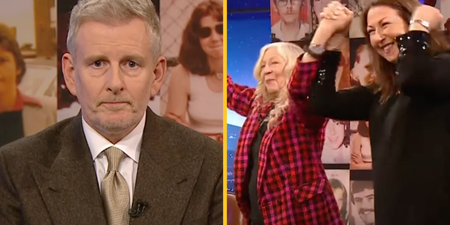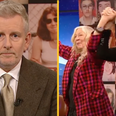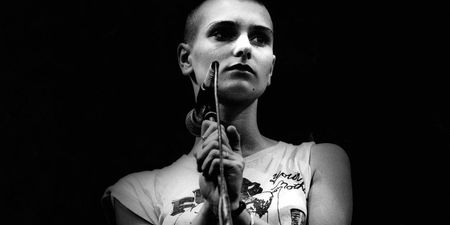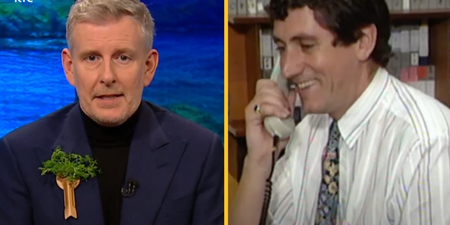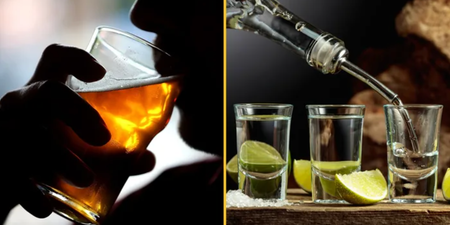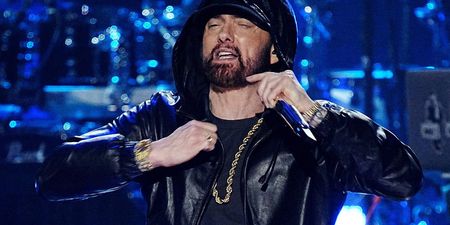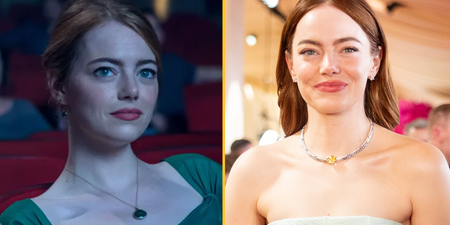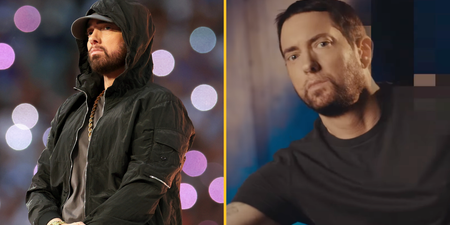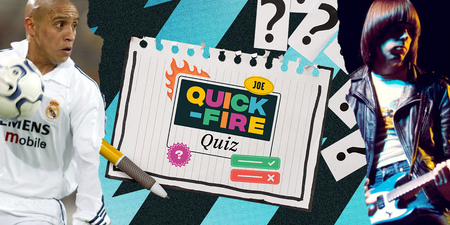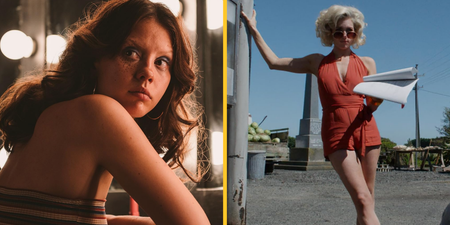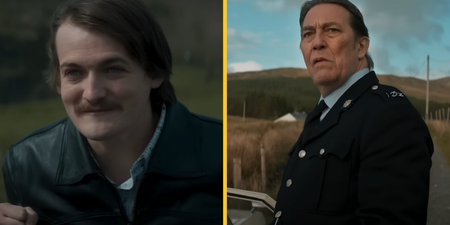Sinéad O’Connor delivered an exceptional performance on Friday night. The response, however, was difficult.
The smile. The wave. The empathy of it all.
There’s an anecdote or two about Sinéad O’Connor‘s infamous Saturday Night Live appearance in October of 1992.
Having performed an a cappella version of Bob Marley’s ‘War’, O’Connor went off-script, presenting a photograph of Pope John Paul II to the camera before defiantly tearing it in two.
“Fight the real enemy,” she encouraged. SNL producers had expected the then 24-year-old to hold aloft a picture of a refugee child, as she had done in the dress rehearsal.
The story goes that NBC Vice President Rick Ludwin “literally jumped out of his chair” as the Pope was reduced to tatters. In the control booth, producers cut cameras away, with SNL head Lorne Michaels insisting that the applause sign stay switched off.
In turn, a bemused audience sat in silence. Recalling the incident years later when it may seem somewhat benign today, SNL staff spoke of still-present anger while patting themselves on the back for shutting O’Connor down as best they could.
When the show returned one week later, guest host Joe Pesci proudly raised up a taped-up photograph of Pope John Paul II, claiming he had salvaged the original image, to applause, whoops and cheers.
“I’ll tell you one thing,” Pesci noted.
“She was very lucky it wasn’t my show, ’cause if it was my show, I would have gave her such a smack.” Laughter. Cheers. Pause for applause.
Clip via Saturday Night Live
Despite his eventual attempts to talk himself down, Pesci clearly cared a great deal about it.
Many people did. This was widely viewed as a deeply sinful act of betrayal, despite O’Connor’s perfectly valid form of protest, highlighting years of unanswered sexual abuse within the Catholic Church.
Easier to vilify and attempt to destroy a young woman bravely using her platform to speak out, perhaps. Critics were out in force, including Madonna, who brutalised O’Connor in the press as she conveniently plugged her new album.
This was a different time, years before the likes of Marilyn Manson and Slipknot showed up to provoke parental nightmares, and even that feels so very quaint today.
27 years on, Sinéad O’Connor’s statement remains potent.
Her behaviour and personality throughout her career – outspoken, unconventional, fearlessly honest – threatens to overshadow an artist who, if anything, is arguably underrated and should be regarded as one of the great talents that this country has produced.
And yet we’re very quick to throw stones, aren’t we?
Evidence of that exceptional talent and some ugly conversational fallout were in plentiful supply over the weekend, as O’Connor stole the night on The Late Late Show’s season premiere with a stunning rendition of ‘Nothing Compares 2 U’, a song written by Prince, but one that belongs entirely to her.
Clip via The Late Late Show
In conversation with host Ryan Tubridy, she spoke at length and quite eloquently about converting to Islam, a religion she herself initially came to with prejudice.
“When I started reading, and when I read just chapter two of the Quran, alone, I realised, ‘Oh my god, I’m home, I’ve been a Muslim all my life and I didn’t realise it’,” O’Connor, now also going by the name Shuhada Sadaqat, said.
“It’s a way of thinking, Islam. You could almost be a Muslim without offically being a Muslim. It’s a headset. A Muslim is only a person who believes that nothing in the universe should be worshipped except God.”
Asked by Tubridy what wearing a hijab gives her, O’Connor explained:
“It’s the same as when I say I was born into Christianity – I didn’t choose it – I was born into it and I love it, and why I like Islam is I get to keep Christianity and I get to keep Judaism, both two religions I loved and studied.
“To me, the hijab is the same as when I used to wear a crucifix,” she added.
“It’s just identifying yourself as being a Muslim and part of a family. It is a family when you become a Muslim.”
All very reasonable, you’d think. And though social media and below-the-line commentary lit up with praise in many corners for both O’Connor’s musical performance and warm, calm demeanour, a truly grotesque side of the Internet and people’s selective application of empathy was dishearteningly visible.
Sinead O'Connor on about reverting to Islam.#LateLate pic.twitter.com/kH3kNPcrCr
— RTÉ One (@RTEOne) September 6, 2019
Words like “insane” and “crazy” and “nutjob” and “oddball” and “mad” were thrown about with reckless abandon by people with profile and cover photographs that present them alongside young children, everyone smiling, all happy in the moment.
You know how these things go; the procession of negativity and in-fighting in comment sections and similar real-time forums. People happy to spend their Friday night and Saturday morning shouting at each other, or simply parachuting in barbed one-word censures like those above.
O’Connor’s appearance was mocked, as religious intolerance was found alive and unwell in a country that has suffered through so much horror via a creed that so many of us grew up in the shadow of, instructed, daily, at home and in school and in church, that this isn’t just the way to enlightenment and purity, but the only way.
And so we gather together and demonise one of our own because she looks a bit different in a ceremonial gown that we don’t understand the meaning of.
We are threatened by a woman who has publicly struggled with life, as we all do, some more vulnerable than others. We choose not to celebrate a display of strength and passion, but condemn it from the comfort of our phones with an emoji or a GIF thrown in for good measure.
We fire off the word “bitch” like it’s nothing about a woman who we would almost certainly rush to deify if she passed away tomorrow.
Alive? She’s sport.
Don’t get this writer wrong; it’s not everybody, and it is pleasing to see the other side as people unite to hail what feels like a powerful cultural moment, at least in the blink-and-you’ll-miss-it modern age, but there’s an argument about the fickle side of human nature buried in there, too.
O’Connor certainly isn’t infallible, either. A Facebook post in the summer of 2015 decrying Rolling Stone’s choice of placing Kim Kardashian on its front cover, stating that “music has officially died” while labelling Kardashian a “cunt”, was a highly disappointing take, to look at one recent-ish happening.
But that’s social media and hot takes for you.
We’re all likely guilty to some degree in such regard. It’s just that sometimes the bile is so gleefully casual, shockingly ignorant, unflinchingly nasty, and frightening in its frequency that you stop to take a breath and wonder just why this is all so accepted, predictable, and seemingly unstoppable.
At the conclusion of ‘Nothing Compares 2 U’ on Friday evening in the RTÉ studio, the camera zooms in, quick but respectful, on O’Connor’s features.
She catches it, smiles, and waves. There’s grace there, and the feeling of a life lived, lessons learned, battles overcome, and maybe, just maybe, a sense of peace.
What’s that saying again?
Céad Míle Fáilte.
A hundred thousand welcomes.
We ought not to run out of them.
LISTEN: You Must Be Jokin’ with Aideen McQueen – Faith healers, Coolock craic and Gigging as Gaeilge
